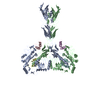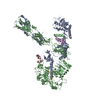[English] 日本語
 Yorodumi
Yorodumi- PDB-8vjc: Cryo-EM structure of short form insulin receptor (IR-A) with thre... -
+ Open data
Open data
- Basic information
Basic information
| Entry | Database: PDB / ID: 8vjc | ||||||
|---|---|---|---|---|---|---|---|
| Title | Cryo-EM structure of short form insulin receptor (IR-A) with three IGF2 bound, asymmetric conformation. | ||||||
 Components Components |
| ||||||
 Keywords Keywords |  SIGNALING PROTEIN / SIGNALING PROTEIN /  Insulin receptor / IGF2 / RTK Insulin receptor / IGF2 / RTK | ||||||
| Function / homology |  Function and homology information Function and homology informationspongiotrophoblast cell proliferation / positive regulation of skeletal muscle tissue growth / negative regulation of muscle cell differentiation / embryonic placenta morphogenesis / regulation of muscle cell differentiation / Signaling by Type 1 Insulin-like Growth Factor 1 Receptor (IGF1R) / IRS-related events triggered by IGF1R / regulation of female gonad development /  genomic imprinting / positive regulation of meiotic cell cycle ...spongiotrophoblast cell proliferation / positive regulation of skeletal muscle tissue growth / negative regulation of muscle cell differentiation / embryonic placenta morphogenesis / regulation of muscle cell differentiation / Signaling by Type 1 Insulin-like Growth Factor 1 Receptor (IGF1R) / IRS-related events triggered by IGF1R / regulation of female gonad development / genomic imprinting / positive regulation of meiotic cell cycle ...spongiotrophoblast cell proliferation / positive regulation of skeletal muscle tissue growth / negative regulation of muscle cell differentiation / embryonic placenta morphogenesis / regulation of muscle cell differentiation / Signaling by Type 1 Insulin-like Growth Factor 1 Receptor (IGF1R) / IRS-related events triggered by IGF1R / regulation of female gonad development /  genomic imprinting / positive regulation of meiotic cell cycle / positive regulation of organ growth / positive regulation of developmental growth / genomic imprinting / positive regulation of meiotic cell cycle / positive regulation of organ growth / positive regulation of developmental growth /  insulin-like growth factor II binding / male sex determination / exocrine pancreas development / insulin-like growth factor II binding / male sex determination / exocrine pancreas development /  insulin receptor complex / insulin receptor complex /  insulin-like growth factor I binding / positive regulation of multicellular organism growth / insulin-like growth factor I binding / positive regulation of multicellular organism growth /  insulin receptor activity / positive regulation of protein-containing complex disassembly / cargo receptor activity / positive regulation of vascular endothelial cell proliferation / insulin receptor activity / positive regulation of protein-containing complex disassembly / cargo receptor activity / positive regulation of vascular endothelial cell proliferation /  dendritic spine maintenance / dendritic spine maintenance /  insulin binding / insulin binding /  PTB domain binding / neuronal cell body membrane / adrenal gland development / Signaling by Insulin receptor / IRS activation / positive regulation of activated T cell proliferation / PTB domain binding / neuronal cell body membrane / adrenal gland development / Signaling by Insulin receptor / IRS activation / positive regulation of activated T cell proliferation /  transmembrane receptor protein tyrosine kinase activator activity / amyloid-beta clearance / activation of protein kinase activity / positive regulation of respiratory burst / transmembrane receptor protein tyrosine kinase activator activity / amyloid-beta clearance / activation of protein kinase activity / positive regulation of respiratory burst /  regulation of embryonic development / positive regulation of receptor internalization / positive regulation of cell division / transport across blood-brain barrier / regulation of embryonic development / positive regulation of receptor internalization / positive regulation of cell division / transport across blood-brain barrier /  insulin receptor substrate binding / embryonic placenta development / epidermis development / positive regulation of glycogen biosynthetic process / SHC-related events triggered by IGF1R / Signal attenuation / insulin receptor substrate binding / embryonic placenta development / epidermis development / positive regulation of glycogen biosynthetic process / SHC-related events triggered by IGF1R / Signal attenuation /  phosphatidylinositol 3-kinase binding / heart morphogenesis / positive regulation of insulin receptor signaling pathway / dendrite membrane / striated muscle cell differentiation / Insulin receptor recycling / phosphatidylinositol 3-kinase binding / heart morphogenesis / positive regulation of insulin receptor signaling pathway / dendrite membrane / striated muscle cell differentiation / Insulin receptor recycling /  insulin-like growth factor receptor binding / insulin-like growth factor receptor binding /  receptor-mediated endocytosis / neuron projection maintenance / activation of protein kinase B activity / positive regulation of glycolytic process / protein serine/threonine kinase activator activity / Insulin receptor signalling cascade / positive regulation of mitotic nuclear division / insulin-like growth factor receptor signaling pathway / platelet alpha granule lumen / receptor-mediated endocytosis / neuron projection maintenance / activation of protein kinase B activity / positive regulation of glycolytic process / protein serine/threonine kinase activator activity / Insulin receptor signalling cascade / positive regulation of mitotic nuclear division / insulin-like growth factor receptor signaling pathway / platelet alpha granule lumen /  learning / learning /  caveola / positive regulation of glucose import / animal organ morphogenesis / caveola / positive regulation of glucose import / animal organ morphogenesis /  growth factor activity / positive regulation of MAP kinase activity / growth factor activity / positive regulation of MAP kinase activity /  insulin receptor binding / insulin receptor binding /  hormone activity / hormone activity /  receptor internalization / receptor internalization /  receptor protein-tyrosine kinase / receptor protein-tyrosine kinase /  memory / cellular response to growth factor stimulus / osteoblast differentiation / peptidyl-tyrosine phosphorylation / cellular response to insulin stimulus / Regulation of Insulin-like Growth Factor (IGF) transport and uptake by Insulin-like Growth Factor Binding Proteins (IGFBPs) / male gonad development / memory / cellular response to growth factor stimulus / osteoblast differentiation / peptidyl-tyrosine phosphorylation / cellular response to insulin stimulus / Regulation of Insulin-like Growth Factor (IGF) transport and uptake by Insulin-like Growth Factor Binding Proteins (IGFBPs) / male gonad development /  cell surface receptor protein tyrosine kinase signaling pathway / glucose metabolic process / positive regulation of nitric oxide biosynthetic process / positive regulation of peptidyl-tyrosine phosphorylation / cell surface receptor protein tyrosine kinase signaling pathway / glucose metabolic process / positive regulation of nitric oxide biosynthetic process / positive regulation of peptidyl-tyrosine phosphorylation /  integrin binding / late endosome / integrin binding / late endosome /  glucose homeostasis / Platelet degranulation / insulin receptor signaling pathway / glucose homeostasis / Platelet degranulation / insulin receptor signaling pathway /  amyloid-beta binding / PI5P, PP2A and IER3 Regulate PI3K/AKT Signaling / amyloid-beta binding / PI5P, PP2A and IER3 Regulate PI3K/AKT Signaling /  protein tyrosine kinase activity / in utero embryonic development / positive regulation of MAPK cascade / protein autophosphorylation / protein tyrosine kinase activity / in utero embryonic development / positive regulation of MAPK cascade / protein autophosphorylation /  lysosome / lysosome /  receptor ligand activity / positive regulation of phosphatidylinositol 3-kinase/protein kinase B signal transduction / receptor ligand activity / positive regulation of phosphatidylinositol 3-kinase/protein kinase B signal transduction /  receptor complex / endosome membrane / carbohydrate metabolic process / positive regulation of cell migration / positive regulation of protein phosphorylation receptor complex / endosome membrane / carbohydrate metabolic process / positive regulation of cell migration / positive regulation of protein phosphorylationSimilarity search - Function | ||||||
| Biological species |   Homo sapiens (human) Homo sapiens (human) | ||||||
| Method |  ELECTRON MICROSCOPY / ELECTRON MICROSCOPY /  single particle reconstruction / single particle reconstruction /  cryo EM / Resolution: 3.8 Å cryo EM / Resolution: 3.8 Å | ||||||
 Authors Authors | An, W. / Hall, C. / Li, J. / Huang, A. / Wu, J. / Park, J. / Bai, X.C. / Choi, E. | ||||||
| Funding support |  United States, 1items United States, 1items
| ||||||
 Citation Citation |  Journal: Nat Commun / Year: 2024 Journal: Nat Commun / Year: 2024Title: Activation of the insulin receptor by insulin-like growth factor 2. Authors: Weidong An / Catherine Hall / Jie Li / Albert Hung / Jiayi Wu / Junhee Park / Liwei Wang / Xiao-Chen Bai / Eunhee Choi /  Abstract: Insulin receptor (IR) controls growth and metabolism. Insulin-like growth factor 2 (IGF2) has different binding properties on two IR isoforms, mimicking insulin's function. However, the molecular ...Insulin receptor (IR) controls growth and metabolism. Insulin-like growth factor 2 (IGF2) has different binding properties on two IR isoforms, mimicking insulin's function. However, the molecular mechanism underlying IGF2-induced IR activation remains unclear. Here, we present cryo-EM structures of full-length human long isoform IR (IR-B) in both the inactive and IGF2-bound active states, and short isoform IR (IR-A) in the IGF2-bound active state. Under saturated IGF2 concentrations, both the IR-A and IR-B adopt predominantly asymmetric conformations with two or three IGF2s bound at site-1 and site-2, which differs from that insulin saturated IR forms an exclusively T-shaped symmetric conformation. IGF2 exhibits a relatively weak binding to IR site-2 compared to insulin, making it less potent in promoting full IR activation. Cell-based experiments validated the functional importance of IGF2 binding to two distinct binding sites in optimal IR signaling and trafficking. In the inactive state, the C-terminus of α-CT of IR-B contacts FnIII-2 domain of the same protomer, hindering its threading into the C-loop of IGF2, thus reducing the association rate of IGF2 with IR-B. Collectively, our studies demonstrate the activation mechanism of IR by IGF2 and reveal the molecular basis underlying the different affinity of IGF2 to IR-A and IR-B. | ||||||
| History |
|
- Structure visualization
Structure visualization
| Structure viewer | Molecule:  Molmil Molmil Jmol/JSmol Jmol/JSmol |
|---|
- Downloads & links
Downloads & links
- Download
Download
| PDBx/mmCIF format |  8vjc.cif.gz 8vjc.cif.gz | 374.6 KB | Display |  PDBx/mmCIF format PDBx/mmCIF format |
|---|---|---|---|---|
| PDB format |  pdb8vjc.ent.gz pdb8vjc.ent.gz | 284.5 KB | Display |  PDB format PDB format |
| PDBx/mmJSON format |  8vjc.json.gz 8vjc.json.gz | Tree view |  PDBx/mmJSON format PDBx/mmJSON format | |
| Others |  Other downloads Other downloads |
-Validation report
| Arichive directory |  https://data.pdbj.org/pub/pdb/validation_reports/vj/8vjc https://data.pdbj.org/pub/pdb/validation_reports/vj/8vjc ftp://data.pdbj.org/pub/pdb/validation_reports/vj/8vjc ftp://data.pdbj.org/pub/pdb/validation_reports/vj/8vjc | HTTPS FTP |
|---|
-Related structure data
| Related structure data |  43280MC  8u4bC  8u4cC  8u4eC  8vjbC C: citing same article ( M: map data used to model this data |
|---|---|
| Similar structure data | Similarity search - Function & homology  F&H Search F&H Search |
- Links
Links
- Assembly
Assembly
| Deposited unit | 
|
|---|---|
| 1 |
|
- Components
Components
| #1: Protein | Mass: 155329.094 Da / Num. of mol.: 2 Source method: isolated from a genetically manipulated source Source: (gene. exp.)   Homo sapiens (human) / Gene: INSR / Production host: Homo sapiens (human) / Gene: INSR / Production host:   Homo sapiens (human) Homo sapiens (human)References: UniProt: P06213,  receptor protein-tyrosine kinase receptor protein-tyrosine kinase#2: Protein |  Insulin-like growth factor 2 Insulin-like growth factor 2Mass: 20170.398 Da / Num. of mol.: 3 Source method: isolated from a genetically manipulated source Source: (gene. exp.)   Homo sapiens (human) / Gene: IGF2 / Production host: Homo sapiens (human) / Gene: IGF2 / Production host:   Escherichia coli (E. coli) / References: UniProt: P01344 Escherichia coli (E. coli) / References: UniProt: P01344 |
|---|
-Experimental details
-Experiment
| Experiment | Method:  ELECTRON MICROSCOPY ELECTRON MICROSCOPY |
|---|---|
| EM experiment | Aggregation state: PARTICLE / 3D reconstruction method:  single particle reconstruction single particle reconstruction |
- Sample preparation
Sample preparation
| Component | Name: Short form insulin receptor (IR-A) with three IGF2 bound, asymmetric conformation. Type: COMPLEX / Entity ID: all / Source: RECOMBINANT |
|---|---|
| Molecular weight | Experimental value: NO |
| Source (natural) | Organism:   Homo sapiens (human) Homo sapiens (human) |
| Source (recombinant) | Organism:   Homo sapiens (human) Homo sapiens (human) |
| Buffer solution | pH: 7.5 |
| Specimen | Embedding applied: NO / Shadowing applied: NO / Staining applied : NO / Vitrification applied : NO / Vitrification applied : YES : YES |
Vitrification | Cryogen name: ETHANE |
- Electron microscopy imaging
Electron microscopy imaging
| Experimental equipment |  Model: Titan Krios / Image courtesy: FEI Company |
|---|---|
| Microscopy | Model: FEI TITAN KRIOS |
| Electron gun | Electron source : :  FIELD EMISSION GUN / Accelerating voltage: 300 kV / Illumination mode: FLOOD BEAM FIELD EMISSION GUN / Accelerating voltage: 300 kV / Illumination mode: FLOOD BEAM |
| Electron lens | Mode: BRIGHT FIELD Bright-field microscopy / Nominal defocus max: 2600 nm / Nominal defocus min: 1600 nm / Alignment procedure: COMA FREE Bright-field microscopy / Nominal defocus max: 2600 nm / Nominal defocus min: 1600 nm / Alignment procedure: COMA FREE |
| Specimen holder | Cryogen: NITROGEN / Specimen holder model: FEI TITAN KRIOS AUTOGRID HOLDER |
| Image recording | Electron dose: 60 e/Å2 / Film or detector model: GATAN K3 BIOQUANTUM (6k x 4k) |
| EM imaging optics | Energyfilter name : GIF Bioquantum / Energyfilter slit width: 20 eV : GIF Bioquantum / Energyfilter slit width: 20 eV |
- Processing
Processing
| EM software |
| ||||||||||||||||||||||||||||||
|---|---|---|---|---|---|---|---|---|---|---|---|---|---|---|---|---|---|---|---|---|---|---|---|---|---|---|---|---|---|---|---|
CTF correction | Type: PHASE FLIPPING AND AMPLITUDE CORRECTION | ||||||||||||||||||||||||||||||
| Particle selection | Num. of particles selected: 3422813 | ||||||||||||||||||||||||||||||
| Symmetry | Point symmetry : C1 (asymmetric) : C1 (asymmetric) | ||||||||||||||||||||||||||||||
3D reconstruction | Resolution: 3.8 Å / Resolution method: FSC 0.143 CUT-OFF / Num. of particles: 79813 / Symmetry type: POINT | ||||||||||||||||||||||||||||||
| Atomic model building | Protocol: RIGID BODY FIT / Space: REAL |
 Movie
Movie Controller
Controller






 PDBj
PDBj











